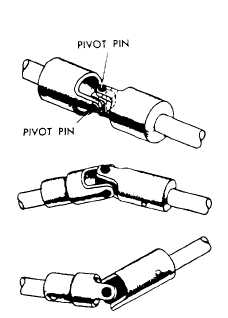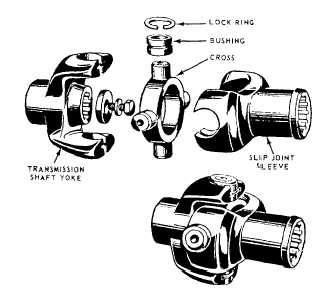Figure 11-21.-Universal joint (Hooke type).
Figure 11-22.-Ring-and-trunnion universal joint.
forms. They are used in nearly all types and classes of
machinery. An elementary universal joint, sometimes
called a Hooke joint (fig. 11-21), consists of two
U-shaped yokes fastened to the ends of the shafts to be
connected. Within these yokes is a cross-shaped part that
holds the yokes together and allows each yoke to bend,
or pivot, in relation to the other. With this arrangement,
one shaft can drive the other even though the angle
between the two is as great as 25° from alignment.
Figure 11-22 shows a ring-and-trunnion universal
joint. It is merely a slight modification of the old Hooke
joint. Automobile drive shaft systems use two, and
sometimes three, of these joints. You will read more
about these in chapter 13 of this book.
The Bendix-Weiss universal joint (fig. 11-23)
provides smoother torque transmission but less
structural strength. In this type of joint, four large balls
transmit the rotary force, with a smaller ball as a spacer.
With the Hooke type universal joint, a whipping motion
occurs as the shafts rotate. The amount of whip depends
on the degree of shaft misalignment. The Bendix-Weiss
joint does not have this disadvantage; it transmits rotary
motion with a constant angular velocity. However, this
type of joint is both more expensive to manufacture and
of less strength than the Hooke type.
CAMS
A cam is a rotating or sliding piece of machinery (as
a wheel or a projection on a wheel). A cam transfers
motion to a roller moving against its edge or to a pin free
to move in a groove on its face. A cam may also receive
motion from such a roller or pin. Some cams do not
move at all, but cause a change of motion in the
contacting part. Cams are not ordinarily used to transmit
power in the sense that gear trains are used. They are
used to modify mechanical movement, the power for
which is furnished through other means. They may
control other mechanical units, or they may synchronize
or lock together two or more engaging units.
Cams are of many shapes and sizes and are widely
used in machines and machine tools (fig. 11-24). We
classify cams as
1. radial or plate cams,
2. cylindrical or barrel cams, and
3. pivoted beams.
A similar type of cam includes drum or barrel cams,
edge cams, and face cams.
The drum or barrel cam has a path cut around its
outside edge in which the roller or follower fits. It
imparts a to-and-from motion to a slide or lever in a
plane parallel to the axis of the cam. Sometimes we build
these cams upon a plain drum with cam plates attached.
Plate cams are used in 5"/38 and 3"/50 guns to open
the breechblock during counter-recoil.
Edge or peripheral cams, also called disc cams,
operate a mechanism in one direction only. They rely on
gravity or a spring to hold the roller in contact with the
edge of the cam. The shape of the cam suits the action
required.
11-12




